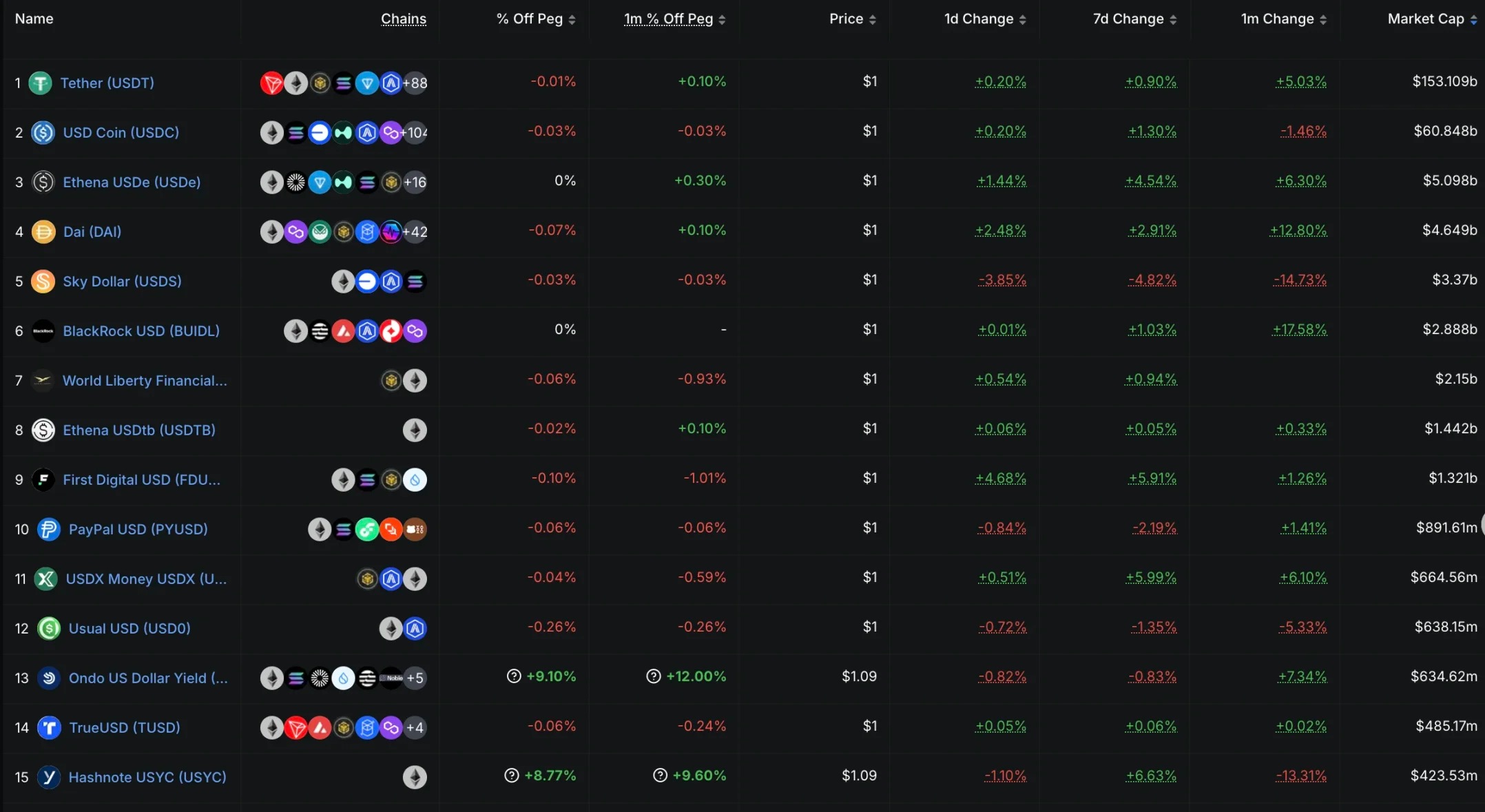撰文:Wenser,Odaily 星球日报
随着 BTC 价格接近 112000 美元的新高,美国稳定币监管法案《天才法案》同样整装待发,加密行业与全球经济体系进一步深度耦合,这个时候人们才发现:支付体系才是加密行业的王冠,而 BTC 则是王冠上的那颗明珠。这也是在加密资产主流化进程日益加快的当下,PayFi、U 卡、RWA 转而成为交易所、加密项目方扎堆聚集的必争之地的原因之一。未来,基于现实世界的细分行业的独立支付解决方案或许将成为可能。
本文,Odaily 星球日报将对稳定币行业过往发展历史及未来走向予以简要梳理及探讨。
稳定币大变局:起源于 USDT 的加密旧 10 年(2014-2024 年)
2008 年,一篇名为《比特币:一种点对点的电子货币系统》(Bitcoin: A Peer-to-Peer Electronic Cash System)的文章出现在 P2P Foundation 网站上,它的作者署名为 Satoshi Nakamoto,也就是后来被加密行业尊称为祖师爷的中本聪。彼时正值因美元通胀严重而爆发的 2008 年次贷危机落下帷幕之后,世界经济正在缓慢地重建当中。毋庸置疑的是,BTC 的诞生初衷,就是为了解决中心化的货币供给体系与冗长、僵化、死板的全球金融支付体系的沉疴痼疾的。
但出乎包括中本聪在内的很多加密 OG 意料之外的事情是,最终完成「BTC 的点对点支付遗愿」的,并非高举去中心化主义大旗的 BTC,反而是与美元、美债强绑定的各类稳定币。
USDT 的崛起之路:农村包围城市,用例夺取市场
纵观 Tether 的发家史,我们可以粗略地将其归类为「三步走战略」:
(1)从加密血液到加密石油
2014 年 10 月,Tether 创立,彼时其核心产品为基于比特币 Omni 协议发行的稳定币 USDT;
2015 年 2 月,USDT 上线当时比特币交易量最大的交易平台 Bitfinex,Tether CEO Paolo Ardoino 也是 Bitfinex 的 CTO,两家公司因团队成员高度重合一直以来都被外界视为「兄弟公司」;
2018 年,Tether 在以太坊上发行了基于 ERC 20 标准的 USDT,这一标准下的 USDT 与原协议兼容,进一步提升了其使用的便捷性,自此,Tether 与 USDT 借助以太坊生态发展的东风,如同加密血液一样开始逐渐渗透进入加密生态的肌体之中。
2019 年,波场 TRON 与 Tether 成功联姻,自此,波场 TRON 开始在稳定币网络头部生态的路上一路狂飙,前者成为占据 USDT 发行量超三分之一的重量级合作网络,波场创始人孙宇晨也通过前期的撒币策略让波场 TRON 一跃成为加密货币基建之一。
可以说,在早期的赎回手续费盈利模式得到成功验证之后,Tether 已经通过 USDT 建立起了自己的竞争壁垒与商业模式,逐渐成为了加密生态网络的石油原料一般的交易等价物。
(2)从来自加密到不止于加密
时间进入 2020 年,随着 DeFi Summer 的爆发,稳定币的市值规模一路水涨船高,抢占先机红利的,自然非 Tether 及 USDT 莫属,而 Tether 的野心,自然也不再局限于加密世界,而是逐步扩张到更大的范围内。
正如我们此前在《「第一稳定币」USDT 市值创新高,揭秘 Tether 背后的千亿商业帝国》一文中提到的那样:USDT 的使用场景包括加密货币一般等价物、通货膨胀地区的替代性货币、跨境贸易的主要支付工具等等;此外,Tether 在获得海量利润回报之后,又通过各类投资、收购、美债储备、黄金储备及 BTC 储备进一步将自己的手脚伸向整个世界经济体系之中,加强与加密世界之外的勾连。这也是 USDT 饱受「洗钱帮凶」等诟病的重要原因之一。毕竟,金钱永不眠,USDT 同样如此。
(3)从支付手段到价值存储
2021 年,在与纽约州总检察长办公室(NYAG)达成和解、缴纳美国商品期货交易委员会 4100 万美元罚款之后,Tether 阶段性地扫清了自己发展前路上的最大障碍,自此,USDT 的价值开始从支付手段逐渐升级至价值存储。在经历了此前的脱锚风波、储备资产 Fud 等等事件之后,Tether 发行的 USDT 成为高风险、高波动的加密市场上为数不多的囤币对象——另一个对象是 BTC。尤其是不断买入美债的举动,与美元 1 : 1 绑定的市场地位以及品牌认知最终成功得到了加密人群的认可,而每年数十亿乃至上百亿美元的利润更是为其提供了摘得「孪生美元」这一招牌的底气。
从曾经野蛮生长的加密项目,到如今登堂入室的稳定币霸主,Tether 与 USDT 上演了一场「农村包围城市、用例夺取市场」的精彩大戏。
USDC 的第二条路:中心化发展、加密 IPO
与 Tether 发行的 USDT 不同,背靠 Coinbase 发家的 Circle 及旗下稳定币 USDC 走上了一条截然不同的道路:一切为了合规而打造。
除去常规的美债储备以外,Circle 的盈利模式相较 Tether 无疑更为脆弱,毕竟,Coinbase、Binance 等合作方就能吃掉其一大半盈利,而这也是其在特朗普上台后发力推动加密 IPO 上市的重要原因之一——只有抓住合规的已有优势,及时将自己的基本盘从加密货币领域扩展到传统金融市场,才能获得更强的议价权并在后续的市场竞争中获得更为强有力的资金、资源乃至政策支持。
除去 USDT、USDC 这两大市场巨头以外,从市场早期的 TrueUSD(TUSD)、Circle Coin(USDC)、Gemini Dollar(GUSD)、Paxos(PAX),再到如今仍然占据一定市场的 DAI(MakerDAO)、USDS(Sky)、USDe(Ethena)、PYUSD(PayPal)、RLUSD(Ripple)、USD1 (WLFI)等其他稳定币项目,事关这块利润肥美的「蛋糕」的竞争无疑日趋激烈,而谁能够真正立于不败之地或者成为最终的赢家,仍然有待监管政策的考验和时间的验证。

https://defillama.com/stablecoins
美国《天才法案》掀起稳定币监管浪潮:补上加密监管的最后一块版图
对于所有的稳定币项目而言,美国参议院近期投票「放行」的稳定币监管法案《天才法案》无疑就是那把高悬于头上的达摩克利斯之剑,而在比特币现货 ETF、以太坊现货 ETF 已成为传统机构资金配置仓位组成部分之后,该法案无疑将补上特朗普政府加密监管的最后一块版图。
具体而言,在笔者个人看来,天才法案的主要目的在于:
1. 确保美元霸权。作为「 America First」的忠实拥趸,特朗普及其政府成员乃至民主党成员的核心目的仍然是确保美国的政治经济霸权,而实现这一点的主要媒介,就是美元。与美元 1: 1 绑定挂钩的稳定币无疑是最佳工具之一。
2. 确保稳定币体系运转处于美国辖制范围内。在加密友好环境已成定局的现在,美国正在重新成为加密热土,而这将帮助美国在稳定币运转体系以及监管政策制定等方面掌握主动权,届时,如同曾经的外贸条例一样,美国将通过稳定币体系实现对全球加密经济乃至跨境贸易的全面压制。
3. 确保加密金融体系的部分安全。这也是此次《天才法案》得到不少行业人士以及传统金融行业代表人士的正面肯定的重要原因之一,强制的 1: 1 足额资产储备且严禁挪用及再质押、每月至少发布一次储备报告并引入外部审计的高频词信息披露、流通市值超 100 亿美元后的银行业级别监管牌照以及引入托管机构等规定都将为稳定币赛道加上一刀又一道的的保险锁。当然,至于锁的后面那扇大门是否坚固,这是另外一个问题了。
4. 极大地打开了 RWA 赛道的想象空间,链上链下世界结合更为紧密。可以说,稳定币才是最早期的 RWA 产品,而其绑定的现实世界资产就是美元货币。随着《天才法案》的逐步落地,RWA 相关法案的推出以及落地实施相信也并不遥远,相较于目前超 3 万亿美元的加密货币市场,那将是一个高达数十万亿美元的资产市场。
就此,《天才法案》将为美国政府以及美国经济发展数字经济、挖掘数字资产潜力、鼓励加密项目发展提供政策性红利,催生出一批极具发展前景的加密项目及其背后的团队。身负加密未来的天才或许就深藏其中。
加密新 10 年:金融仍是主线,加密概念股、股票代币化大有可为
站在 2025 年来看,加密人群在全球人口占比已经阶段性见顶,加密货币投资目前仍是少数人的游戏;但另一方面来看,商业社会中,每个人都具备着商品交换的天然需求,这里商品可以是有形的产品、物品,也可以是无形的劳动、虚拟资产、数字 IP 等等,所以,基于这样的需求,更加便捷、低成本、更加安全的加密支付终将渗透到每个人的日常生活。
下一个 10 年(2025 年 -2035 年),加密货币行业的主线或许将从此前市场证伪的多个赛道、领域逐步收缩到金融领域,由此,基于加密 IPO 产生的加密概念股以及股票代币化将成为加密行业的新阵地。
某些层面而言,目前 Strategy、Sol Strategy、Metaplanet 等上市公司的股票已经成为了加密概念股、股票代币化的「二象性载体」了,而在 BTC 的价值得到更大范围乃至更高价格的肯定之后,他们的潜在价值也将得到进一步释放。
当然,肉眼可见的范围内,ETH 生态、Solana 生态仍然是当下行业的主流选择。
结语:中本聪「遗志」终实现,但实现方式却背道而驰
文章的最后,我们仍然难以避开比特币创始人中本聪这位已经消失在市场视野的加密巨擘,而秉承其 「BTC 点对点支付系统」的集大成者,毫无疑问是稳定币。
只不过,稍显讽刺的是,心怀加密朋克精神的他或许也无法料到,为了对抗威权政府毫无节制、日益膨胀的铸币权而诞生的 BTC,反而催生了更加「以美元为中心、以美债为保障」的稳定币体系。
免责声明:本文章仅代表作者个人观点,不代表本平台的立场和观点。本文章仅供信息分享,不构成对任何人的任何投资建议。用户与作者之间的任何争议,与本平台无关。如网页中刊载的文章或图片涉及侵权,请提供相关的权利证明和身份证明发送邮件到support@aicoin.com,本平台相关工作人员将会进行核查。




